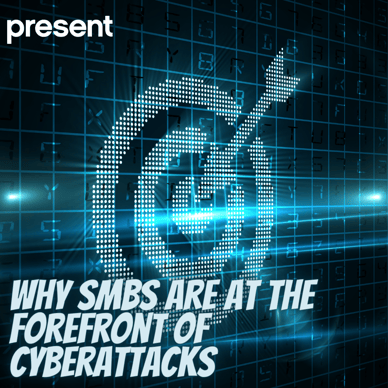Present Blog – IT Thought Leadership
Blog Present-IT thought leadership
Blog Present-IT thought leadership
IT thought leadership blog for CIOs and CTOs in Canada seeking resources to drive IT as a business contributor: hybrid cloud, infrastructure, managed services and security and IT recruitment.
Why SMBs Are at the Forefront of Cyberattacks: Understanding Vulnerabilities and Mitigation Strategies
present Contrary to popular belief, the size and scale of an organization do not serve as deterrents for cybercriminals; instead, they often present lucrative opportunities. Even though cyberattacks on small and medium-sized businesses (SMBs) don't often make the headlines, they are often the target for several reasons. This article delves into why cybercriminals set their sights on SMEs and outlines actionable strategies to enhance cybersecurity resilience.
Contrary to popular belief, the size and scale of an organization do not serve as deterrents for cybercriminals; instead, they often present lucrative opportunities. Even though cyberattacks on small and medium-sized businesses (SMBs) don't often make the headlines, they are often the target for several reasons. This article delves into why cybercriminals set their sights on SMEs and outlines actionable strategies to enhance cybersecurity resilience.
1. The Double-Edged Sword of Technological Adoption
The pandemic really pushed SMEs to accelerate their digital journey. They had to quickly get on board with remote work setups and start using cloud-based platforms. Sure, these tech changes made things more flexible and efficient, but they also brought in some new weak spots. Unfortunately many SMEs don't have a ton of IT know-how or resources to set up top-notch cybersecurity measures. That leaves them with gaps that cybercriminals are quick to exploit.
2. The Illusion of Invisibility
A prevalent misconception among SMEs is the belief that their modest size renders them inconspicuous to cybercriminals. However, statistics paints a starkly different picture. According to Mastercard, SMEs face cyberattacks at double the rate of large enterprises, underscoring their attractiveness as targets. Cybercriminals capitalize on SMEs' limited cybersecurity infrastructure and awareness, viewing them as lucrative entry points to larger supply chains or networks.
3. Cybersecurity: An Overlooked Priority
Despite the escalating frequency and sophistication of cyber threats, cybersecurity often remains a lower priority on SMEs' strategic agendas. This complacency stems from limited awareness, budget constraints, and competing operational priorities. Consequently, SMEs inadvertently expose themselves to a myriad of cyber risks, ranging from data breaches and ransomware attacks to phishing scams and insider threats.
The Imperative of Cyber Insurance for SMEs
In the ever-changing world of cyber threats, having cyber insurance is a must for small and medium-sized businesses (SMEs). Surprisingly, not many are on board with this idea – only 52% of SMEs have cyber insurance, while larger companies boast a 75% adoption rate.
Navigating the Complex Landscape of Cyber Insurance
Evolving Cost Dynamics: The rise in cyber incidents has led to a spike in cyber insurance costs for small and medium-sized businesses (SMEs), adding to their financial stress and operational challenges.
Stringent Underwriting Criteria: Insurance companies are setting tough standards for small and medium-sized businesses (SMEs), making them tighten up their cybersecurity game. This means SMEs have to beef up their defenses with things like multi-factor authentication, data encryption, and solid incident response plans.
Strategies for Enhancing Cyber Resilience
To navigate the intricate cybersecurity landscape effectively, SMEs must adopt a proactive and multifaceted approach:
Invest in Cybersecurity Education and Training: Nurture a culture of cybersecurity awareness within your workforce by providing employees with the knowledge and skills to effectively recognize and address potential threats. This proactive approach ensures that everyone is well-equipped to contribute to the overall cybersecurity defense, fostering a collective commitment to identify and mitigate potential risks.
Partner with Specialized Cybersecurity Providers like Present: Team up with trusted cybersecurity partners such as Present to craft customized security solutions that align seamlessly with your organization's specific requirements and budget constraints. This collaborative approach ensures that you get tailored measures that not only suit your needs but also fit within your financial parameters.
Implement Robust Security Measures: Strengthen your digital defenses and tackle vulnerabilities head-on by embracing a layered security strategy. This involves incorporating tools like firewalls, intrusion detection systems, endpoint protection, and conducting regular security audits. It's all about covering all bases for a more robust defense against cyber threats.
Conclusion
SMEs are facing new and intricate challenges in the ever-changing world of cyber threats. The key to overcoming these challenges lies in acknowledging vulnerabilities, making cybersecurity a top priority, and taking a proactive and strategic stance. By treating cybersecurity as a fundamental rather than a secondary concern, SMEs can strengthen their resilience against cyber threats. This not only safeguards their assets and reputation but also ensures their long-term viability.
When SMEs view cybersecurity as a strategic imperative, it empowers them to navigate the digital landscape with confidence, fostering growth, innovation, and sustained success.
About Blog
The right use of technology addresses business challenges and drives business growth in all areas of an enterprise. We hope this blog will offer insight into developing strategies and tactics to enable you to identify those key drivers of growth and keep pace with and anticipate the rapid technology change of today.
Posts by Topic
- IT infrastructure (116)
- IT security (92)
- IT Innovation (59)
- Trends (51)
- Cloud (47)
- Managed services (46)
- Mobility (38)
- Digital transformation (29)
- CIO/IT leaders (28)
- Events (28)
- News (23)
- Microsoft 365 (17)
- Security (17)
- IBM (16)
- Disaster recovery (DR) (14)
- High availability (12)
- Recruitment (12)
- Storage (12)
- Big Data (11)
- Collaboration (11)
- AI (9)
- Case study (9)
- Office 365 (9)
- BYOD (8)
- Customer Experience (8)
- Hybrid Cloud (7)
- Current events (6)
- SAP Hana (5)
- Business intelligence (BI) (4)
- Converged infrastructure (4)
- Convergence / Hyper-convergence (4)
- Virtualization (4)
- Copilot (3)
- Future of retail (2)
- Retail (2)
- trend (2)
- Backups (1)
- Beacon (1)
- Blog Migrations (1)
- Contests (1)
- Infrastructure TI (1)
- Innovation TI (1)
- IoT (1)
- MDM (1)
- Stockage (1)
- Virtualisation (1)
- blockchain (1)
- cio (1)
- replication (1)
- Étude de cas (1)
